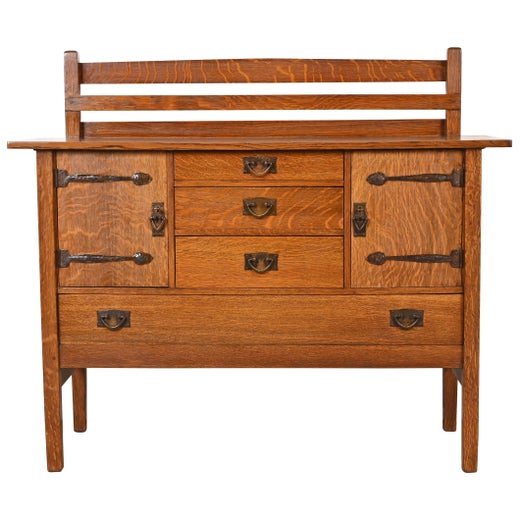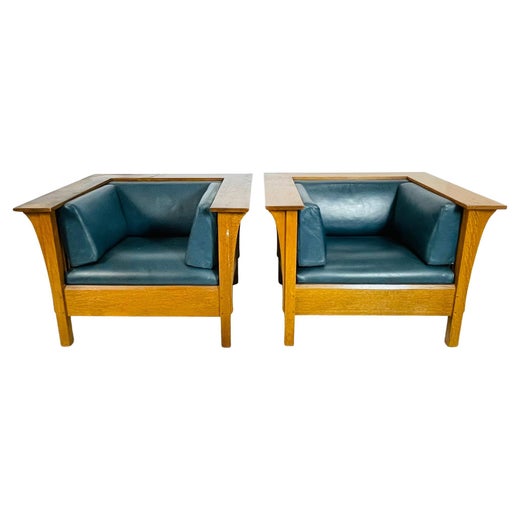L & J.G. Stickley Trestle Library Table
About the Item
- Creator:L. & J.G. Stickley Inc. (Manufacturer),Gustav Stickley (Designer)
- Dimensions:Height: 29 in (73.66 cm)Width: 48 in (121.92 cm)Depth: 30 in (76.2 cm)
- Style:Arts and Crafts (Of the Period)
- Materials and Techniques:
- Place of Origin:
- Period:
- Date of Manufacture:circa 1920s
- Condition:Wear consistent with age and use. Minor fading. Very sound condition, and over all shows well, but does have normal wear for age and use. More photos on request.
- Seller Location:San Francisco, CA
- Reference Number:1stDibs: LU955022666182
Gustav Stickley
Gustav Stickley was one of the principal figures in the American Arts and Crafts movement and the creator of the Craftsman style. As a furniture designer and publisher of the magazine The Craftsman, he adopted many of the ideals of the British design reform movement and popularized both its philosophy and its aesthetics in the United States.
Born in Wisconsin, Stickley moved with his family to Pennsylvania when he was a teenager and began working in his uncle’s chair factory in the town of Brandt. There, he learned the techniques of late-19th-century furniture making at a time when the vogue was for Victorian revival furniture, which was characterized by extensive ornamentation.
In 1883, Stickley established a furniture company called Stickley Brothers with two of his brothers, Albert and Charles (Gustav’s other siblings, Leopold and John George, would later form L & J.G. Stickley Inc.). When Stickley Brothers foundered, he partnered five years later with salesman Elgin Simonds to form a new firm, Stickley & Simonds, which produced traditional furniture that appealed to the burgeoning American middle class. The success of this venture enabled Stickley to travel to Europe, where he discovered the writings of John Ruskin and William Morris, the two preeminent thinkers of the British Arts and Crafts movement. Stickley also traveled to France, where the Art Nouveau movement impressed him with its imaginative designs and skilled craftsmanship.
Stickley parted ways with Simonds at the turn of the 20th century and decided to focus his creative energies on producing furniture in what became known as the Craftsman style, incorporating some of the elements of the designs and movements he had encountered in Europe.
The pieces Stickley created, which he stamped with the logo of a joiner’s compass, were rectilinear, largely free of ornament, made of oak, and built in such a way that the nature of their construction was plainly visible — all reflections of the tenets of the Arts and Crafts movement. While some people referred to Stickley’s furniture as Mission furniture — a term that references the furnishings of the Spanish missions in California — Gustav commonly called his work “Craftsman” owing to the inspiration he found in the British Arts and Crafts movement.
Stickley benches and rocking chairs were popular, and his leather-upholstered armchairs combine practicality, comfort and an understated silhouette. He also made side tables — an unusual example designed during the early 20th century was adorned with an octagonal Grueby Pottery tile in a cool shade of green, which made it an ideal piece for an art pottery collector.
In 1901, Stickley launched The Craftsman magazine, which contained articles on all manner of domestic topics, from gardening and cooking to art and design, as well as poetry and fiction. In addition to popularizing Stickely’s own designs, the magazine acquainted Americans with the Arts and Crafts style in all its forms through its graphic design and the bungalows, art pottery, and hammered-copper lamps pictured in its pages. It also encouraged readers to practice craft themselves, promoting an early form of the do-it-yourself ethos.
In 1904, Stickley founded the Craftsman Home Builders' Club, which allowed subscribers to his magazine to order architectural plans for the Arts and Crafts–style structures that were featured in its pages; eventually, this became one of its most popular features.
An ill-timed attempt to set up a New York showroom led to Stickley’s filing for bankruptcy in 1915. The outbreak of World War I, waning interest in the Arts and Crafts style, and increased competition all conspired to thwart Stickley's efforts. The Craftsman ceased publication a year later. When he died, in 1942, Arts and Crafts had been replaced by modernism as the favored aesthetic. It enjoyed a resurgence, however, in the 1970s, and Stickley is now regarded as one of the most important American designers in the first half of the 20th century.
Find antique Gustav Stickley tables, seating and other furniture on 1stDibs.
L. & J.G. Stickley Inc.
Gustav Stickley was one of the principal figures in the American Arts and Crafts movement and the creator of the Craftsman style. In 1883, Stickley established a furniture company called Stickley Brothers with two of his brothers, Albert and Charles. Gustav’s other siblings, Leopold and John George, would later form L & J.G. Stickley Inc. in Fayetteville, New York, in 1905.
As a furniture designer and publisher of the magazine The Craftsman, Gustav adopted many of the ideals of the British design reform movement and popularized both its philosophy and its aesthetics in the United States.
Born in Wisconsin, Stickley moved with his family to Pennsylvania when he was a teenager and began working in his uncle’s chair factory in the town of Brandt. There, he learned the techniques of late-19th-century furniture making at a time when the vogue was for Victorian revival furniture, which was characterized by extensive ornamentation.
When Stickley Brothers foundered, Gustav partnered five years later with salesman Elgin Simonds to form a new firm, Stickley & Simonds, which produced traditional furniture that appealed to the burgeoning American middle class. The success of this venture enabled Stickley to travel to Europe, where he discovered the writings of John Ruskin and William Morris, the two preeminent thinkers of the British Arts and Crafts movement. Stickley also traveled to France, where the Art Nouveau movement impressed him with its imaginative designs and skilled craftsmanship.
Stickley parted ways with Simonds at the turn of the 20th century and decided to focus his creative energies on producing furniture in what became known as the Craftsman style, incorporating some of the elements of the designs and movements he had encountered in Europe.
The pieces Stickley created, which he stamped with the logo of a joiner’s compass, were rectilinear, largely free of ornament, made of oak, and built in such a way that the nature of their construction was plainly visible — all reflections of the tenets of the Arts and Crafts movement. While some people referred to Stickley’s furniture as Mission furniture — a term that references the furnishings of the Spanish missions in California — Gustav commonly called his work “Craftsman” owing to the inspiration he found in the British Arts and Crafts movement.
Stickley benches and rocking chairs were popular, and his leather-upholstered armchairs combine practicality, comfort and an understated silhouette. In 1901, Stickley launched The Craftsman magazine, which contained articles on all manner of domestic topics, from gardening and cooking to art and design, as well as poetry and fiction. In addition to popularizing Stickely’s own designs, the magazine acquainted Americans with the Arts and Crafts style in all its forms through its graphic design and the bungalows, art pottery, and hammered-copper lamps pictured in its pages. When Gustav Stickley died, in 1942, Arts and Crafts had been replaced by modernism as the favored aesthetic.
The work of L & J.G. Stickley flourished even as the Arts and Crafts style fell out of fashion because Leopold and John George adapted to the changing times.
L & J.G. Stickley changed their brand name and maker’s mark to Handcraft in 1906, and rather than continue to produce Arts & Crafts-inspired designs, their bedroom furnishings, dining room chairs and other items of the era reflected the influence of Frank Lloyd Wright and the Prairie School style as well as the work of the Wiener Werkstätte. Later, Leopold’s Cherry Valley collection appealed to enthusiasts of American Colonial furniture.
Find antique L & J.G. Stickley tables, seating, case pieces and more on 1stDibs.
You May Also Like
Antique 19th Century European Neoclassical Desks and Writing Tables
Wood
Antique Early 19th Century English Desks and Writing Tables
Wood
Antique 19th Century English Victorian Desks
Leather, Mahogany
Antique 19th Century British William IV Desks and Writing Tables
Wood
Vintage 1970s American Desks and Writing Tables
Metal
Antique 19th Century French Louis XIII Desks and Writing Tables
Oak
Antique 19th Century French Louis XVI Desks and Writing Tables
Carrara Marble
Antique 1810s English Regency Desks and Writing Tables
Amboyna
Antique Late 18th Century English George III Desks and Writing Tables
Mahogany
Antique 1860s English High Victorian Desks and Writing Tables
Hardwood

